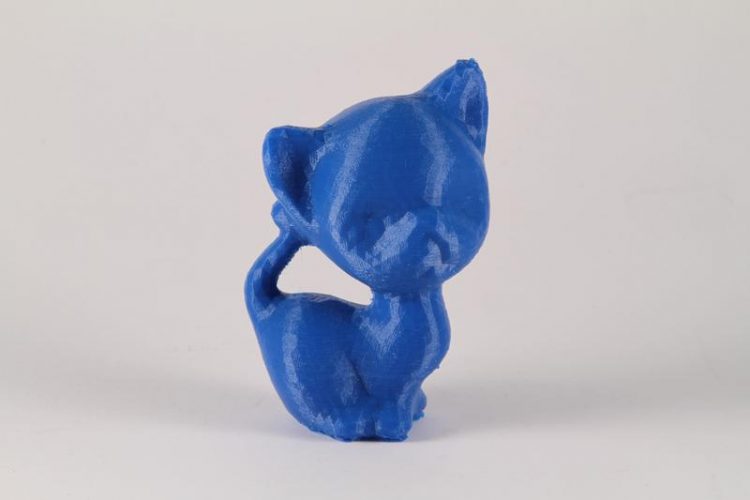Who can find the fish that makes the best sound?

An object made of plastic is optimized to withstand a certain kind of stress particularly well. TU Wien
Which sound will you hear if you strike a little metal fish with a drum stick? The answer to this question is fairly easy to work out using a computer these days. It is much more difficult to determine the shape of a metal object in order to generate a specific sound.
The team led by Przemyslaw Musialski at TU Wien joined forces with Leif Kobbelt from RWTH Aachen to find a way to make this possible. Thanks to their work, specific complex requirements can now be defined for objects – including the sound they make or how resistant they are to certain mechanical stresses – and a computer algorithm is used to adapt the object such that it meets these particular specifications.
Changes to wall thickness
“We produce hollow objects or open shells with walls which are not uniform in their thickness,” explains Przemyslaw Musialski, Head of the Computational Fabrication Group at the Center for Geometry and Computational Design at TU Wien. “This variation in thickness allows us to adjust a whole range of properties in a targeted manner.” For example, an object made of plastic can be optimized such that it can withstand a certain kind of stress particularly well. The computer calculates how forces are distributed and what inner stresses are at play. The distribution of forces can be improved significantly by making changes to the wall thickness at the right points.
A similar process is used to change the sound made by metal objects. In order to demonstrate this principle, the team at TU Wien chose a number of different animal shapes, including a giraffe and a fish, and used the computer algorithm to adjust the thickness of the metal in such a way that a specific sound spectrum is exhibited when the objects are struck. They ended up with what is effectively a zoo glockenspiel!
New method to speed up calculations
“We are talking about some quite complex calculations here,” explains Musialski. “When you can change the thickness at any point, the number of different possibilities is huge. It is just not possible to simulate every single one of them on a computer. Instead, what you need is a carefully designed method that allows you to find a solution within a reasonable time frame.”
The important thing to remember is that in these cases there is normally not just one single solution. There is usually a range of shapes that will achieve the outcome one is looking for. Rather than finding the ideal shape, one just needs to ensure that the computer outputs a result that is sufficient.
“On this basis, we have managed to devise a new optimization method that reduces the design space drastically,” explains Przemyslaw Musialski. “It is then possible to find a good solution in the remaining subspace with great efficiency.” The results of the research were presented at the ACM SIGGRAPH 2016 conference and published in the journal ACM Transactions on Graphics (TOG) recently.
Video:
Several results achieved using the new method are presented in this video, including the zoo glockenspiel, a rabbit-shaped bell and a plastic cat that can withstand high mechanical stresses:
https://youtu.be/AScDKsL5H7g
Original publication: http://dl.acm.org/author_page.cfm?id=99658729263
Musialski P, Hafner C, Rist F, Birsak M, Wimmer M, Kobbelt L
Non-linear shape optimization using local subspace projections. ACM Trans Graph.
2016; 35(4):1-13. DOI: 10.1145/2897824.2925886.
Picture download: https://www.tuwien.ac.at/dle/pr/aktuelles/downloads/2017/fisch
Further information:
Dr. Przemyslaw Musialski
TU Wien
Institute of Discrete Mathematics and Geometry
Wiedner Hauptstr. 8, 1040 Vienna
T: +43-1-58801-10442
przemyslaw.musialski@tuwien.ac.at
https://youtu.be/AScDKsL5H7g Several results achieved using the new method are presented in this video, including the zoo glockenspiel, a rabbit-shaped bell and a plastic cat that can withstand high mechanical stresses
Media Contact
All latest news from the category: Information Technology
Here you can find a summary of innovations in the fields of information and data processing and up-to-date developments on IT equipment and hardware.
This area covers topics such as IT services, IT architectures, IT management and telecommunications.
Newest articles

Superradiant atoms could push the boundaries of how precisely time can be measured
Superradiant atoms can help us measure time more precisely than ever. In a new study, researchers from the University of Copenhagen present a new method for measuring the time interval,…

Ion thermoelectric conversion devices for near room temperature
The electrode sheet of the thermoelectric device consists of ionic hydrogel, which is sandwiched between the electrodes to form, and the Prussian blue on the electrode undergoes a redox reaction…

Zap Energy achieves 37-million-degree temperatures in a compact device
New publication reports record electron temperatures for a small-scale, sheared-flow-stabilized Z-pinch fusion device. In the nine decades since humans first produced fusion reactions, only a few fusion technologies have demonstrated…





















